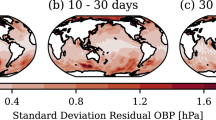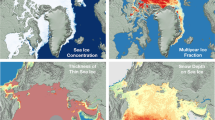Abstract
The rain rate (RR) retrieval method for the RR estimation over ice-free areas of the ocean is presented. Measurements of the Japanese Advanced Microwave Scanning Radiometer 2 (AMSR2) on board the satellite GCOM-W1 are used. The method is based on the results of the numerical modeling of brightness temperatures of the outgoing microwave radiation of the ocean–atmosphere system and their subsequent conversion into the RR using neural networks. A simplified form of the transfer equation is used. Its errors for the considered wavelengths do not exceed 1 K at an RR of less than 20 mm/h. The method is verified by comparison with the Tropical Rainfall Measuring Mission’s (TRMM) Microwave Instrument (TMI) RR product. As a result of the comparison, the rain rate retrieval error within the range of 20 mm/h is found to be 1 mm/h.
Similar content being viewed by others
References
A. Behrangi, M. Lersock, S. Wong, and B. Lambrigtsen, “On the quantification of oceanic rainfall using spaceborne sensors,” J. Geophys. Res. 117 (D20) (2012). doi 10.1029/2012.TD017979
T. T. Wilheit, “Some comments on passive microwave measurement of rain,” Bull. Am. Meteorol. Soc. 67 (10), 1226–1232 (1986).
G. W. Petty and K. Li, “Improved passive microwave retrievals of rain rate over land and ocean. Part I: Algorithm description,” J. Atmos. Ocean. Technol. 30 (11), 2493–2508 (2013).
R. J. Kuligowski, “A self-calibrating real-time GOES rainfall algorithm for short-term rainfall estimates,” J. Hydrometeorol. 3 (2), 112–130 (2002).
C. Kummerow, W. Barnes, T. Kozu, J. Shine, et al., “The tropical rainfall measuring mission (TRMM) sensor package,” J. Atmos. Ocean. Technol. 15 (3), 809–817 (1998).
A. Behrangi, G. Stephens, R. F. Adler, et al., “An update on the oceanic precipitation rate and its zonal distribution in light of advanced observations from space,” J. Clim. 2 (11), 3957–3965 (2014).
R. J. Joyce, J. E. Janowiak, P. A. Arkin, and P. Xie, “CMORPH: A method that produces global precipitation estimates from passive microwave and infrared data at high spatial and temporal resolution,” J. Hydrometeorol. 5 (3), 487–503 (2004).
A. AghaKouchak, A. Mehran, H. Norouzi, and A. Behrangi, “Systematic and random error components in satellite precipitation data sets,” Geophys. Res. Lett. 39 (9) (2012). doi 10.1029/2012G.L051592
A. Y. Hou and R. K. Kakar, S. Neeck, et al., “The Global Precipitation Measurement (GPM) Mission,” Bull. Am. Meteorol. Soc. 95 (5), 711–722 (2014).
K. A. Hilburn and F. J. Wentz, “Intercalibrated passive microwave rain products from the unified microwave ocean retrieval algorithm (UMORA),” J. Appl. Meteorol. Climatol. 47 (3), 778–794 (2008).
F. J. Turk, Z. S. Haddad, and Y. You, “Principal components of multifrequency microwave land surface emissivities. Part I: Estimation under clear and precipitating conditions,” J. Hydrometeorol. 15 (1), 3–19 (2014).
C. Kummerow and L. Giglio, “A passive microwave technique for estimating rainfall and vertical structure information from space. Part I: Algorithm description,” J. Appl. Meteorol. 33 (1), 3–18 (1994).
R. R. Ferraro, “Special sensor microwave imager derived global rainfall estimates for climatological applications,” J. Geophys. Res. 102 (D14), 16715–16735 (1997).
P. Bauer and P. Schluessel, “Rainfall, total water, ice water, and water vapor over sea from polarized microwave simulations and Special Sensor Microwave/Imager data,” J. Geophys. Res. 98 (D11), 20737–20759 (1993).
C. Kummerow and R. Ferraro, Algorithm Theoretical Basis Document: EOS/AMSR-E Level-2 Rainfall. Colorado State Univ. Rep., 2007.
B. Lin and W. B. Rossow, “Precipitation water path and rainfall rate estimates over oceans using special sensor microwave imager and International Satellite Cloud Climatology Project data,” J. Geophys. Res. 102 (D8), 9359–9374 (1997).
S. Chandrasekhar, Radiative Transfer (Dover Publications, New York, 1960).
K. Imaoka, M. Kachi, M. Kasahara, et al., “Instrument performance and calibration of AMSR-E and AMSR2,” Int. Arch. Photogramm. Remote Sens. Spec. Inf. Sci 38 (8), 13–18 (2010).
H. J. Liebe and D. H. Layton, Millimeter-wave properties of the atmosphere: Laboratory studies and propagation modeling, NTIA Rep. 87–24. Nat. Tech. Inf. Service Boulder, Colorado, 1987.
S. Y. Matrosov and E. M. Shulgina, “Scattering and attenuation of microwave radiation by precipitation,” MGO Trans. 448, 85–94 (1982).
D. L. Wu, J. H. Jiang, and C. P. Davis, “EOS MLS cloud ice measurements and cloudy-sky radiative transfer model,” IEEE Trans. Geosci. Remote Sens. 44 (5), 1156–1165 (2006).
S. Yu. Matrosov, “Microwave radiation transfer in precipitation,” Tr. Gl. Geofiz. Obs. im. A.I. Voeikova, No. 478, 50–61 (1983).
D. D. Turner, M. P. Cadeddu, U. Lohnert, et al., “Modifications to the water vapor continuum in the microwave suggested by ground-based 150-GHz observations,” IEEE Trans. Geosci. Remote Sens. Lett. 47 (10), 3326–3337 (2009).
T. Meissner and F. J. Wentz, “The complex dielectric constant of pure and sea water from microwave satellite observations,” IEEE Trans. Geosci. Remote Sens. 42 (9), 1836–1849 (2004).
B. Chapron, A. Bingham, F. Collard, et al., “Ocean remote sensing data integration-examples and outlook,” in Proc. Ocean. Sustain. Ocean Obs. Inf. Soc., WPP-306 (ESA, Venice, Italy, 2010). doi 10.5270/OceanObs09
K. Hilburn, D. Smith, and T. Meissner, “Assessment of remote sensing systems version-7 rain rates,” EGU Gen. Assem. Conf. Abstr. 15, 6120 (2013).
Author information
Authors and Affiliations
Corresponding author
Additional information
Original Russian Text © E.V. Zabolotskikh, B. Chapron, 2016, published in Izvestiya AN. Fizika Atmosfery i Okeana, 2016, Vol. 52, No. 1, pp. 92–99.
Rights and permissions
About this article
Cite this article
Zabolotskikh, E.V., Chapron, B. Neural network-based method for the estimation of the rain rate over oceans by measurements of the satellite radiometer AMSR2. Izv. Atmos. Ocean. Phys. 52, 82–88 (2016). https://doi.org/10.1134/S0001433816010114
Received:
Accepted:
Published:
Issue Date:
DOI: https://doi.org/10.1134/S0001433816010114




